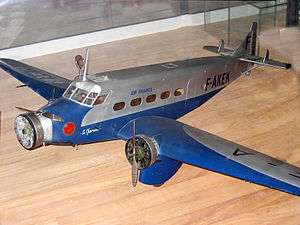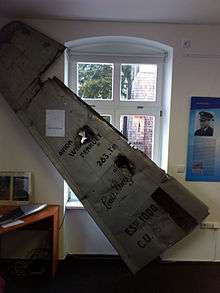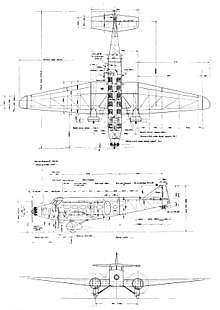Wibault 280
| Wibault 280-T | |
|---|---|
 | |
| Scale model of Wibault 283.T12 F-AMYF | |
| Role | 12-passenger transport monoplane |
| Manufacturer | Wibault |
| First flight | 1930 |
| Primary users | Air France Air Union Aero Portuguesa |
The Wibault 280-T was a French 12-passenger civil airliner produced by Wibault backed by money from the Penhoët shipyards and also known as 'Penhoët Wibault'.[1]
Design and development
The prototype Penhoët Wibault 280-T first flew at Villacoublay in November 1930 with the development backed by funds from the Penhoët shipyards of St Nazaire. It was an all-metal low-wing cantilever monoplane powered by three 300 hp (224 kW) Hispano-Wright 9Qa radial engines although these were soon replaced by three Gnome-Rhône 7Kb and the aircraft was redesignated the Wibault 281-T. A second aircraft was built to the 281 standard but then it was converted to a Wibault 282-T with three 350 hp (261 kW) Gnome-Rhône 7Kd engines and room for 12 passengers, seven further aircraft were built as 282s. Some of the 282s were operated by Air Union on the Paris-London Voile d'Or ("Golden Clipper") service in 1933. In 1934 Air France took delivery of the first of ten Wibault 283-Ts which had an increased fuel capacity and modified tail. Some of the 282s were converted to 283 standard. Some of the commercial aircraft were later taken over as military transports.
Accidents and incidents
- On 9 May 1934, Wibault 282-T F-AMHP of Air France crashed into the English Channel off Dungeness, Kent, United Kingdom, killing all six people on board.
- On 19 May 1934, a Golden Clipper of Air France crash-landed on a cricket pitch adjacent to Croydon Airport, Surrey, United Kingdom, due to fuel exhaustion. Only one of the ten people on board was injured.[2]
- On 24 December 1937, Wibault-Penhoët 283.T12 (c/n 11) F-AMYD of Air France crashed near Zhůří (currently part of Rejštejn), Czechoslovakia, due to a navigational error. The aircraft was supposed to land at Prague, but was directed by controllers to fly south and crashed in foggy, snowy and dark conditions after 120 km (75 mi). Two pilots and a single passenger were killed.[3]

Variants
- Penhoët Wibault 280-T
- Prototype with three 300hp (224kW) Hispano-Wright 9Qa radial engines, one built converted to a 281.
- Wibault 281-T
- Prototype re-engined with three Gnome-Rhône 7Kb radial engines followed by one other later converted to a 282
- Wibault 282-T
- 12-passenger production variant with three 350hp (261kW) Gnome-Rhône 7Kd radial engines, seven built and one conversion from 281.
- Wibault 283-T
- Production variant for Air France with three 350hp (261kW) Gnome-Rhône 7Kd radial engines, increased fuel capacity, and modified tail, ten built.
Operators
Specifications (283-T-12)

Data from European Transport Aircraft since 1910[4]
General characteristics
- Crew: 2
- Capacity: 10 passengers
- Length: 17.0 m (55 ft 9 in)
- Wingspan: 22.61 m (74 ft 2 in)
- Wing area: 64.4 m2 (693 sq ft)
- Empty weight: 4,266 kg (9,405 lb)
- Gross weight: 6,350 kg (13,999 lb)
- Powerplant: 3 × Gnome-Rhône Titan Major 7Kd 7-cylider air-cooled radial engine, 260 kW (350 hp) each
Performance
- Maximum speed: 251 km/h (156 mph; 136 kn)
- Cruise speed: 230 km/h (143 mph; 124 kn)
- Range: 1,000 km (621 mi; 540 nmi)
- Service ceiling: 5,200 m (17,100 ft)
Notes
- ↑ AIR FRANCE : La Saga Archived 2015-02-06 at the Wayback Machine.
- ↑ "Mishap to French Air Liner". The Times (46759). London. 21 May 1934. col F, p. 7.
- ↑ "Letecká nehoda v r. 1937 na Zhůří u Kvildy". Retrieved 15 January 2013.
- ↑ Stroud 1966, pp. 214–216
References
- Stroud, John (1966). European Transport Aircraft since 1910. London: Putnam.
- Taylor, Michael J. H. (1989). Jane's Encyclopedia of Aviation. London: Studio Editions.
- The Illustrated Encyclopedia of Aircraft (Part Work 1982–1985). Orbis Publishing. pp. 3096–7.
External links
| Wikimedia Commons has media related to Wibault 283-T. |
- "Wings Over Four Continents" Popular Mechanics, December 1935 photo bottom of pg.866, first two photos pg. 867